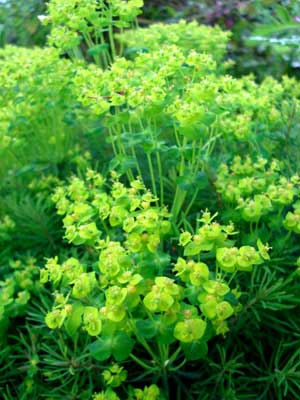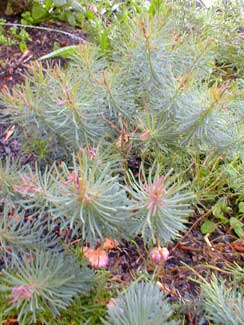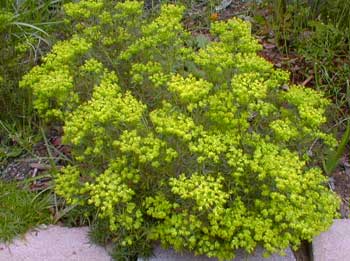
'Fen's Ruby'
Cypress Spurge; aka,
Dwarf Milkwort; or,
Wolf's-milk
"But cockle, spurge, according to their law
Might propagate their kind, with none to awe."
-Robert Browning
1812-1889
1812-1889
 The name 'Fen's Ruby' is a mite misleading since neither the flowers nor the leaves are actually red. New spring leaves start out plum colored, but very soon fade to bluish green; while late spring & early summer blooms are greenish yellow. The flowers for the species are nearly green & don't show well as separate from the foliage, but for 'Fen's Ruby' are showier & yellower, aging to deeper yellow or even orangish.
The name 'Fen's Ruby' is a mite misleading since neither the flowers nor the leaves are actually red. New spring leaves start out plum colored, but very soon fade to bluish green; while late spring & early summer blooms are greenish yellow. The flowers for the species are nearly green & don't show well as separate from the foliage, but for 'Fen's Ruby' are showier & yellower, aging to deeper yellow or even orangish.The thready leaves are much finer than on other euphorbias. 'Fen's Ruby' has finer leaves even than the species. It scarsely looks like a euphorbia except for the flowers, but is a softly clumping little perennial, a ferny or almost fluffy groundcover for partial to full sun in a low-maintenance garden. It will even grow in rocky compacted soil.
It is colorful in autumn, the leaves taking on orange hues. It is semi-evergreen in our mild climate, but will be a die-back perennial in colder zones, returning early in spring from its extremely hardy rhizomes.
It spreads very easily, even aggressively, so that it will require periodic "weeding down" at the periphery of an established colony. But it is not nearly as weedy as the species & is easily controlled if the effort is made. If no effort is made to control it, it will take over. It transplants super-easily & any seedlings that pop up around the edges of a clump or colony can be potted & given to friends.
Like other euphorbias, 'Fen's Ruby' bleeds a white latex that lends the whole genus the common names Wolf's Milk or Milkwort. This sap is very caustic, & the plant should be handled with care, with hands washed afterward in order to guard against accidental injury to the eyes. Gardeners with sensitive skin should wear gloves to handle any euphorbias at all.
 Perhaps its funniest common names given to euphorbias is Wartwort (elsetimes Wartherb). This name reflects the belief that the plant is a medicinal herb (wort means "herb") that treats warts. And indeed it may occasionally have exactly that effect since warts are caused by a virus & the milky latex does have antiviral properties.
Perhaps its funniest common names given to euphorbias is Wartwort (elsetimes Wartherb). This name reflects the belief that the plant is a medicinal herb (wort means "herb") that treats warts. And indeed it may occasionally have exactly that effect since warts are caused by a virus & the milky latex does have antiviral properties.Where the species may have originated, before it began its conquest of much of the northern hemisphere, is not really known, though western Europe is suspected. It has for centuries been growing throughout Eurasia, from England to Siberia. It reached North America in the 1860s as an ornamental plant, having since naturalized in the majority of the continental United States & in Canada.
The species is on several state watchlists as a potential pest-plant, & has already reached invasive pest status in areas around the Great Lakes & New England. It likes open sunny ground, so is a particular hazard in pastures, being inedible & toxic to cattle.
'Fen's Ruby' is smaller & less aggressive than the species & has a reduced likelihood of invading the countryside, although it wouldn't be out of the question. It prefers limey (alkaline) soils, but grows well, in a slightly restrained manner, in our region's naturally acidic soils.